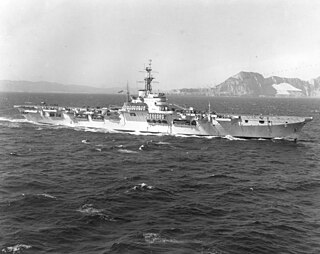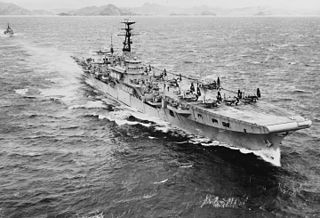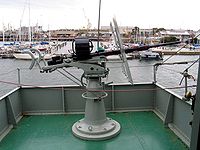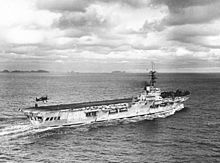Six ships that were built for the Royal Navy have borne the name HMS Ocean. The name Ocean entered the list from which names are selected for British ships in 1759, when the Royal Navy captured the French ship named Océan. The British studied the French technology of this ship and admired it, but the ship had to be in bad shape before it would be replaced by a new-build.

HMS Ocean was a Royal Navy Colossus-class light fleet aircraft carrier of 13,190 tons built in Glasgow by Alexander Stephen & Sons. Her keel was laid in November 1942, and she was commissioned on 8 August 1945.

HMS Warrior was a Colossus-class light aircraft carrier which was ordered in 1942 by the British Royal Navy during World War II. Construction was finished in 1945 and upon completion, the aircraft carrier was loaned to the Royal Canadian Navy from 1946 to 1948 as HMCS Warrior. Warrior was returned to the Royal Navy in 1948 and entered service with the British. While in service with the Royal Navy, Warrior was modernised twice, including the installation of an angled flight deck in 1956. In 1948–1949, the ship was used in aircraft landing experiments and fitted with a rubber flight deck and in 1957, was used as the headquarters ship during nuclear testing at Christmas Island. In 1958, the vessel was sold to the Argentine Navy and entered Argentine service in 1959 as ARA Independencia. The aircraft carrier remained in service until 1970 when Independencia was placed in reserve. The following year, the ship was sold for scrap.
Six ships of the Royal Navy have been named HMS Colossus:

HMS Triumph was a Royal Navy Colossus-class light fleet aircraft carrier. She served in the Korean War and later, after reconstruction, as a support ship.

HMS Illustrious was the lead ship of her class of aircraft carriers built for the Royal Navy before World War II. Her first assignment after completion and working up was with the Mediterranean Fleet, in which her aircraft's most notable achievement was sinking one Italian battleship and badly damaging two others during the Battle of Taranto in late 1940. Two months later the carrier was crippled by German dive bombers and was repaired in the United States. After sustaining damage on the voyage home in late 1941 by a collision with her sister ship Formidable, Illustrious was sent to the Indian Ocean in early 1942 to support the invasion of Vichy French Madagascar. After returning home in early 1943, the ship was given a lengthy refit and briefly assigned to the Home Fleet. She was transferred to Force H for the Battle of Salerno in mid-1943 and then rejoined the Eastern Fleet in the Indian Ocean at the beginning of 1944. Her aircraft attacked several targets in the Japanese-occupied Dutch East Indies over the following year before Illustrious was transferred to the newly formed British Pacific Fleet (BPF). The carrier participated in the early stages of the Battle of Okinawa until mechanical defects arising from accumulated battle damage became so severe she was ordered home early for repairs in May 1945.

USS Hamlin (CVE-15) was one of a large group of escort aircraft carriers built on Maritime Commission C-3 hulls and transferred to the Royal Navy under Lend Lease during World War II. The ship was launched by Western Pipe and Steel Company, San Francisco, California, on 5 March 1942, as AVG-15, aircraft escort vessel. She was sponsored by Mrs. William H. Shea. Her designation was changed to ACV-15, auxiliary aircraft carrier, 20 August 1942, and she was acquired and simultaneously transferred to the United Kingdom 21 December 1942. Hamlin's designation was changed to CVE-15, escort aircraft carrier, 15 July 1943.

HMS Formidable was an Illustrious-class aircraft carrier ordered for the Royal Navy before the Second World War. After being completed in late 1940, she was briefly assigned to the Home Fleet before being transferred to the Mediterranean Fleet as a replacement for her crippled sister ship Illustrious. Formidable's aircraft played a key role in the Battle of Cape Matapan in early 1941, and they subsequently provided cover for Allied ships and attacked Axis forces until their carrier was badly damaged by German dive bombers in May.

HMS Implacable was the name ship of her class of two aircraft carriers built for the Royal Navy during World War II. Upon completion in 1944, she was initially assigned to the Home Fleet and attacked targets in Norway for the rest of the year. She was subsequently assigned to the British Pacific Fleet (BPF) where she attacked the Japanese naval base at Truk and targets in the Japanese Home Islands in 1945. The ship was used to repatriate liberated Allied prisoners of war (PoWs) and soldiers after the Japanese surrender, for the rest of the year. Implacable returned home in 1946 and became the Home Fleet's deck-landing training carrier, a role that lasted until 1950. She briefly served as flagship of the Home Fleet in 1950. During this time she participated in many exercises and made a number of port visits in Western Europe. She was placed in reserve in 1950 and converted into a training ship in 1952, and served as flagship of the Home Fleet Training Squadron. The ship was considered for a major modernisation in 1951–1952, but this was rejected as too expensive and time-consuming. Implacable was decommissioned in 1954 and sold for scrap the following year.

The Centaur class aircraft carrier was the final iteration of the 1942 Design Light Fleet Carrier developed by the United Kingdom for the Royal Navy during the Second World War. They were designed in 1943 to operate higher-performance aircraft than the preceding Majestic-class aircraft carrier. Four ships were laid down in 1944-1945 and completed in 1953-1959. Rapid developments in carrier warfare and technology overtook the ships even as they were under construction, and the associated costs of modernization led to ships being completed to different specifications. Only the last ship, HMS Hermes (R12), was fitted as a modern fixed-wing carrier; she was also the last of the class to retire in 2017 as INS Viraat.

The 1942 Design Light Fleet Carrier, commonly referred to as the British Light Fleet Carrier, was a light aircraft carrier design created by the Royal Navy during the Second World War, and used by eight naval forces between 1944 and 2001. They were designed and constructed by civilian shipyards to serve as an intermediate step between the expensive, full-size fleet aircraft carriers and the less expensive but limited-capability escort carriers.

HMS Glory (R62) was a Colossus-class aircraft carrier of the British Royal Navy laid down on 27 August 1942 by Harland and Wolff at Belfast. She was launched on 27 November 1943 by Lady Cynthia Brooke, wife of the Prime Minister of Northern Ireland.

HMS Pioneer was a Colossus-class aircraft carrier built for the Royal Navy during World War II. She was modified whilst under construction into an aircraft maintenance carrier. The ship arrived in Australia in mid-1945 to support operations by the British Pacific Fleet against Japanese forces. She supported the British attacks on the Japanese Home Islands from mid-June until the end of the war in August from a base in the Admiralty Islands. The ship and her facilities were used to help repair Hong Kong's infrastructure in late 1945 and she returned to the UK in early 1946. Pioneer was immediately placed in reserve upon her arrival and she was sold in 1954 for scrap.

HMS Venerable (R63) was a Colossus-class aircraft carrier of the Royal Navy. She served for only the last few months of World War II, and in 1948 she was sold to the Netherlands and renamed HNLMS Karel Doorman, taking part in the military clash in 1962 in Western New Guinea. Subsequently, she was sold to Argentina and renamed ARA Veinticinco de Mayo, later taking part in the Falklands War.

HMS Perseus was a Colossus-class light fleet aircraft carrier built for the Royal Navy during World War II. The ship was initially named HMS Edgar, but she was renamed in 1944 when the Admiralty decided to convert her into an aircraft maintenance carrier. She was completed in 1945, after the end of World War II, and she made a trip to Australia late in the year. Upon her return to the UK in early 1946, Perseus was placed in reserve. The ship was recommissioned in 1950 to serve as the trials ship for the steam catapult then under development. Over 1,600 test launches were conducted before the catapult was removed in 1952 and she was converted for use as a ferry carrier to transport aircraft, troops and equipment overseas. She was reduced to reserve again in 1954 and sold for scrap in 1958.

USS St. Simon (CVE-51), an escort aircraft carrier originally classified as an auxiliary aircraft carrier, was laid down on 26 April 1943 at Tacoma, Washington, by the Seattle-Tacoma Shipbuilding Corporation, under a Maritime Commission contract ; reclassified as an escort aircraft carrier, CVE-51, on 15 July 1943; launched on 9 September 1943; sponsored by Mrs. R. H. Lewis, the wife of Major General R. H. Lewis, Commanding General, Northwestern Sector, Fort Lewis, Washington; assigned to the Commercial Iron Works, Portland, Oregon, for the completion of construction; and delivered to the Royal Navy, under lend-lease, on 31 December 1943.

ARA Veinticinco de Mayo (V-2) was an aircraft carrier in the Argentine Navy from 1969 to 1997. The English translation of the name is Twenty-fifth of May, which is the date of Argentina's May Revolution in 1810.

HMS Biter was a Royal Navy escort carrier during the Second World War. She was laid down as a merchant ship at the Sun Shipbuilding & Drydock Company yard at Chester, Pennsylvania. Laid down on 28 December 1939, she was converted to an escort carrier and commissioned in the Royal Navy on 6 May 1942. She was returned to the United States in 1945 and subsequently lent to France.

La Fayette was an 11,000-ton Independence-class aircraft carrier that served the French Navy from 1951 to 1963. She was the first French vessel named after the 18th century general Marquis de Lafayette. She was initially USS Langley (CVL-27) serving the United States Navy from 1943 to 1947 before transferring to the French Navy.

The Royal Navy built three aircraft maintenance carriers for its Fleet Air Arm before and during World War II. The Abyssinia Crisis of 1934–35 demonstrated to the Admiralty that it needed a depot ship to support the aircraft carriers in active service, just like submarine and destroyer tenders supported those types. Begun just before the start of World War II in 1939, HMS Unicorn was the first ship built in any navy that could "carry out the full range of aircraft maintenance and repair work in addition to the ability to operate aircraft from the flight deck". Unicorn proved the value of the concept and two similar support ships, Perseus and Pioneer were converted into aircraft maintenance ships by modifying light carriers while still under construction. Unlike Unicorn, neither Pioneer nor Perseus were able to land aircraft; they had to be craned aboard.





















